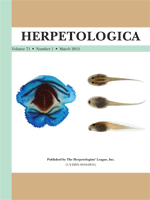Accurate monitoring of wildlife populations is critical for species management and conservation. If management practices are based on inaccurate data, managers might not be implementing management strategies appropriately, which can have severe ecological consequences. We used a generalized linear mixed-model analysis to predict and explain the relative abundance of American Alligators (Alligator mississippiensis) within inland freshwater wetlands. Models were developed for three alligator age classes: hatchlings (≤30.5 cm total length [TL]), subadults (30.6–182.9 cm TL), and adults (≥183 cm TL). Independent variables included environmental parameters that we measured during nighttime surveys. We conducted 135 nighttime alligator surveys, and recorded 7689 observations of alligators in three study lakes. We found that the relative abundance of alligators is variable among age classes and lakes. Final models for each age class differed when lakes were analyzed separately compared with when lakes were combined into one analysis; models differed across age classes as well. These results indicate that alligator occurrence and relative abundance is multifaceted and complex. Survey techniques should accurately quantify age- and population-specific data. Managers and scientists should target particular age classes during surveys on the basis of prevailing environmental conditions.
How to translate text using browser tools
1 March 2015
Responses of American Alligators (Alligator mississippiensis) to Environmental Conditions: Implications for Population and Ecosystem Monitoring
Cord B. Eversole,
Scott E. Henke,
David B. Wester,
Bart M. Ballard,
Randy L. Powell
ACCESS THE FULL ARTICLE

Herpetologica
Vol. 71 • No. 1
March 2015
Vol. 71 • No. 1
March 2015
Crocodilia
habitat
life history
Local environment
Texas
wildlife management




